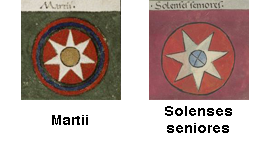
This page created 22 May 2014, and last modified: 29 July 2015 (Maier reference numbers added added)

The second of the eight legiones comitatenses listed (21.16 in Ingo Maier's numbering scheme) under the command of the Magister Militum per Illyricum in the eastern half of the Empire is called the Martii. Its shield pattern (20#6) as shown in various manuscripts, under the matching label (20.f) Martii, is as below:

The pattern shows a red outer rim; an indigo band inside this (but faded to maroon in M; yellow in W, and white in B); and a green band inside this (absent in P, faded to yellow in M and W). The boss is yellow; the main ground is red, and features a 7-pointed white star (light blue in W, 6-pointed in M, and 8-pointed in B). Seven-pointed stars are very rare in the Notitia; the only other infantry example belongs to the Solenses seniores (18.12) under the Magister Militum per Thracias: the units may have formerly been brigaded together.

The name Martii refers to the god Mars (whence the English "Martian"); this unit is, perhaps surprisingly, the only unit so-named in the Notitia; there is also, however, a Legio IIII Martia stationed (61.10) under the Dux Arabiae). While the Martii presumably originated in a legion surnamed Martia, the far-away Legio IIII Martia is a less likely candidate than Legio I Martia, whose tile stamps are well attested in the much closer-to-Illyricum town of Augusta Raurica Augusta Raurica (modern Augst in Switzerland), along with a gravestone bearing the inscription (CIL 13, 5270) MILITAVIT IN L P M, interpreted as "militavit in l(egione) p(rima) M(artia)"; and in various other sites along the Rhine and Danube. These include an inscription (RIU 3, 804) dated to 372 from a fort near Aquincum (Budapest, Hungary) referring to a PP LEGIONIS PRIMAE MARTIORUM, and another (AE 2000, 1223) from the same place dating to 371 referring to a PP LEGIONIS PRIM[......]TIORUM; another (ILS 775 = AE 1999, 1264 = CIL 3.3653) from nearby Solva (modern Esztergom in Hungary), and also dated to 371, also mentions a PRAEPOSITUS LEGIONIS PRIMAE MARTIORUM; while from Neuf-Brisach near Colmar in France, a record (AE 1977, 592) giving [..]G I MARr for"[Le]g(io) I Mart(tia)"; and from nearby Equisheim, another (AE 1941, 32) gives LEG I MAR. Additional inscriptional evidence for Legio I Martia comes from the cemetery at Colonia Iulia Concordia (modern Portogruaro in Veneto, Italy), i.e. very close to Illyricum, which produced an inscription (ILCV 473 = AE 1891, 00102) mentioning the unit in the form of the N PRIME MARTIE VIC, which has been interpreted to mean "numero primae Martiae victricis"; see here for Hoffmann's 1963 analysis (in German).
It should be noted that the name "Martia", in addition to being associated with Mars, was also associated with the tetrarchic emperor Galerius (in the same way Jupiter was associated with Diocletian, Hercules with Maximian, and Sol with Constantius), so Legio IIII Martia was apparently founded during Galerius' reign as Caesar; Legio I Martia might have also been similarly founded during the Tetrarchy.
Thus while the Notitia's Martii is most likely a detachment of Legio I Martia, it would be unwise to assume it was necessarily the only, or even the main body descended from that unit, despite the lack of other Martii in the Notitia, since there are, however, several units named the very similar Martenses, such as the Martenses seniores (15.17) under the Magister Militum per Orientem, and the Martenses (98/9.139), in the Magister Equitum's Gallic command. While the Martenses seniores likely derives from Legio IIII Martia, the Gallic Martenses is a very likely candidate for a unit to have been derived from Legio I Martia.

Return to the Notitia alphabetical unit list page.
Return to my Notitia index page.